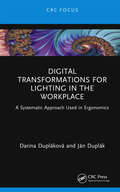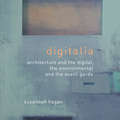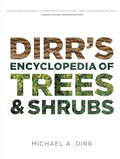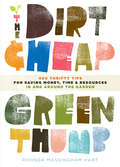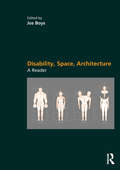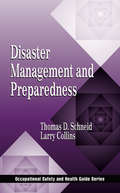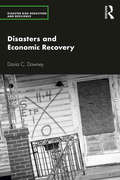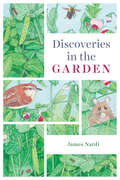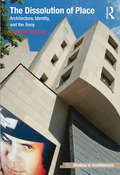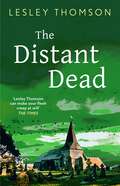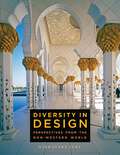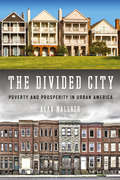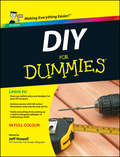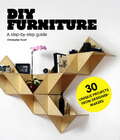- Table View
- List View
Digital Transformations for Lighting in the Workplace: A Systematic Approach Used in Ergonomics
by Darina Dupláková Ján DuplákDigital Transformations for Lighting in the Workplace: A Systematic Approach Used in Ergonomics offers a practical concept for the implementation of digital transformation in ergonomics in work settings. It specifically focuses on providing information about illumination in production and non-production fields, and the described design solutions are applicable in practice. The concepts can be used in a typical manufacturing workplace or an academic setting. The methods in the book complement the modern trend to digitalise the workplace, making the research and practical outcomes of this book compatible with the concept of Industry 4.0 - Digital Manufacturing. This title offers a systematic approach to the field of digital transformation for ergonomics. It presents an opportunity for the reader to learn to create a digital model for lighting by analysing mathematical models for calculation through formulas and simulation algorithms. To put learning into context, this book provides two case studies from the production and non-production sectors, including an example of a classroom. The reader will then be able to utilise the methods to create their own digitized illumination system. This monograph is an ideal read for academics and researchers working at universities in the field of Ergonomics and professionals in industrial management including those in manufacturing plants, ergonomists, designers from the industry sector, or people who are interested in ergonomics, digitization, and simulation of a working environment.
Digital Transformations for Lighting in the Workplace: A Systematic Approach Used in Ergonomics
by Darina Dupláková Ján DuplákDigital Transformations for Lighting in the Workplace: A Systematic Approach Used in Ergonomics offers a practical concept for the implementation of digital transformation in ergonomics in work settings. It specifically focuses on providing information about illumination in production and non-production fields, and the described design solutions are applicable in practice. The concepts can be used in a typical manufacturing workplace or an academic setting. The methods in the book complement the modern trend to digitalise the workplace, making the research and practical outcomes of this book compatible with the concept of Industry 4.0 - Digital Manufacturing. This title offers a systematic approach to the field of digital transformation for ergonomics. It presents an opportunity for the reader to learn to create a digital model for lighting by analysing mathematical models for calculation through formulas and simulation algorithms. To put learning into context, this book provides two case studies from the production and non-production sectors, including an example of a classroom. The reader will then be able to utilise the methods to create their own digitized illumination system. This monograph is an ideal read for academics and researchers working at universities in the field of Ergonomics and professionals in industrial management including those in manufacturing plants, ergonomists, designers from the industry sector, or people who are interested in ergonomics, digitization, and simulation of a working environment.
Digitalia: Architecture and the Digital, the Environmental and the Avant-Garde
by Susannah HaganSusannah Hagan boldly discusses the fraught relationship between key dominating areas of architectural discourse - digital design, environmental design, and avant-garde design.Digitalia firstly demonstrates that drawing such firm lines between architectural spheres is damaging and foolish, particularly as both environmental and avant-garde practices are experimenting with the digital, and secondly remonstrates with an avant-garde that has repudiated the social/ethical agenda of the modernist avant-garde because it failed the first time round. It is environmental architecture that has picked up the social/ethical ball and is running with it, using the digital to very different, and more far-reaching, ends.As the debates rage, this book is a key read for all who are involved or intrigued.
Digitalia: Architecture and the Digital, the Environmental and the Avant-Garde
by Susannah HaganSusannah Hagan boldly discusses the fraught relationship between key dominating areas of architectural discourse - digital design, environmental design, and avant-garde design.Digitalia firstly demonstrates that drawing such firm lines between architectural spheres is damaging and foolish, particularly as both environmental and avant-garde practices are experimenting with the digital, and secondly remonstrates with an avant-garde that has repudiated the social/ethical agenda of the modernist avant-garde because it failed the first time round. It is environmental architecture that has picked up the social/ethical ball and is running with it, using the digital to very different, and more far-reaching, ends.As the debates rage, this book is a key read for all who are involved or intrigued.
Dirr's Encyclopedia of Trees and Shrubs
by Michael A. DirrA combination of Dirr's bestselling books under one cover, adding new plants, new photographs, plus all new commentary in Dirr's signature style, Dirr's Encyclopedia of Trees and Shrubs is the bible of woody plants.
The Dirt-Cheap Green Thumb: 400 Thrifty Tips for Saving Money, Time, and Resources as You Garden
by Rhonda Massingham HartDiscover how frugal gardening can lead to fantastic results! Rhonda Massingham Hart provides practical, time-tested tips that stretch your dollar even as they yield beautiful, bountiful plants. From starting seeds to preserving produce, Hart&’s advice ensures that you won&’t waste time and money while growing your own vegetables, flowers, houseplants, or landscape foliage. Perfect for thrifty gardeners of all levels, The Dirt-Cheap Green Thumb covers everything you want to grow, indoors and out.
Disability, Space, Architecture: A Reader
by Jos BoysDisability, Space, Architecture: A Reader takes a groundbreaking approach to exploring the interconnections between disability, architecture and cities. The contributions come from architecture, geography, anthropology, health studies, English language and literature, rhetoric and composition, art history, disability studies and disability arts and cover personal, theoretical and innovative ideas and work. Richer approaches to disability – beyond regulation and design guidance – remain fragmented and difficult to find for architectural and built environment students, educators and professionals. By bringing together in one place some seminal texts and projects, as well as newly commissioned writings, readers can engage with disability in unexpected and exciting ways that can vibrantly inform their understandings of architecture and urban design. Most crucially, Disability, Space, Architecture: A Reader opens up not just disability but also ability – dis/ability – as a means of refusing the normalisation of only particular kinds of bodies in the design of built space. It reveals how our everyday social attitudes and practices about people, objects and spaces can be better understood through the lens of disability, and it suggests how thinking differently about dis/ability can enable innovative and new kinds of critical and creative architectural and urban design education and practice.
Disability, Space, Architecture: A Reader
by Jos BoysDisability, Space, Architecture: A Reader takes a groundbreaking approach to exploring the interconnections between disability, architecture and cities. The contributions come from architecture, geography, anthropology, health studies, English language and literature, rhetoric and composition, art history, disability studies and disability arts and cover personal, theoretical and innovative ideas and work. Richer approaches to disability – beyond regulation and design guidance – remain fragmented and difficult to find for architectural and built environment students, educators and professionals. By bringing together in one place some seminal texts and projects, as well as newly commissioned writings, readers can engage with disability in unexpected and exciting ways that can vibrantly inform their understandings of architecture and urban design. Most crucially, Disability, Space, Architecture: A Reader opens up not just disability but also ability – dis/ability – as a means of refusing the normalisation of only particular kinds of bodies in the design of built space. It reveals how our everyday social attitudes and practices about people, objects and spaces can be better understood through the lens of disability, and it suggests how thinking differently about dis/ability can enable innovative and new kinds of critical and creative architectural and urban design education and practice.
Disaster Management and Preparedness
by Larry R. CollinsDetailing methods for preparing organizations for disasters, this book discusses not only tried and true tactics, but also areas often overlooked during the reactive and post-disaster phases. The authors address special considerations important in planning for disaster management, from chemical spills, floods, aircraft crashes, and terrorist attack
Disasters and Economic Recovery (Disaster Risk Reduction and Resilience)
by Davia C. DowneyDisasters and Economic Recovery provides perspectives on the economic issues that emerge before, during, and after natural disasters in an international context, by assessing the economic development patterns that emerge before and after disaster. This book will provide a historical overview of emergency management policy and previous responses to disasters in each country, as well as the policy learning that occurred in each case leading up to the disasters under analysis. The book highlights four cases: New Orleans; Christchurch, New Zealand; the Japan earthquake and tsunami; and Hurricane Sandy in the Northeastern United States. The book places important focus on the specific collaborative developments unique to the rebuilding of each place’s economy post-disaster. Using time-series data, the book shows the emergence of new industries and job hiring patterns in the immediate aftermath, as well as provides a picture of the economic performance of each country in the years following each event. Looking at the economic development policies pre- and post-disaster, readers will glean important lessons on how to build resilient economies within the disaster framework, highlighting the differences in approaches to rebuilding local economies in places with varying levels of governmental capacity post-disaster to inform policymakers, scholars, and the disaster relief community as they plan their response to future disasters.
Disasters and Economic Recovery (Disaster Risk Reduction and Resilience)
by Davia C. DowneyDisasters and Economic Recovery provides perspectives on the economic issues that emerge before, during, and after natural disasters in an international context, by assessing the economic development patterns that emerge before and after disaster. This book will provide a historical overview of emergency management policy and previous responses to disasters in each country, as well as the policy learning that occurred in each case leading up to the disasters under analysis. The book highlights four cases: New Orleans; Christchurch, New Zealand; the Japan earthquake and tsunami; and Hurricane Sandy in the Northeastern United States. The book places important focus on the specific collaborative developments unique to the rebuilding of each place’s economy post-disaster. Using time-series data, the book shows the emergence of new industries and job hiring patterns in the immediate aftermath, as well as provides a picture of the economic performance of each country in the years following each event. Looking at the economic development policies pre- and post-disaster, readers will glean important lessons on how to build resilient economies within the disaster framework, highlighting the differences in approaches to rebuilding local economies in places with varying levels of governmental capacity post-disaster to inform policymakers, scholars, and the disaster relief community as they plan their response to future disasters.
Discoveries in the Garden
by James B. NardiEvery square inch of soil is rich with energy and life, and nowhere is this more evident than in the garden. At the tips of our trowels, a sun-driven world of microbes, insects, roots, and stems awaits—and it is a world no one knows better than James Nardi. A charming guide to all things green and growing, Nardi is as at home in prairies, forests, and wetlands as he is in the vegetable patch. And with Discoveries in the Garden, he shows us that these spaces aren’t as different as we might think, that nature flourishes in our backyards, schoolyards, and even indoors. To find it, we’ve only got to get down into the dirt. Leading us through the garden gate, Nardi reveals the extraordinary daily lives and life cycles of a quick-growing, widely available, and very accommodating group of study subjects: garden plants. Through close observations and simple experiments we all can replicate at home, we learn the hidden stories behind how these plants grow, flower, set seeds, and produce fruits, as well as the vital role dead and decomposing plants play in nourishing the soil. From pollinators to parasites, plant calisthenics to the wisdom of weeds, Nardi’s tale also introduces us to our fellow animal and microbial gardeners, the community of creatures both macro- and microscopic with whom we share our raised beds. Featuring a copse of original, informative illustrations that are as lush as the garden plants themselves, Discoveries in the Garden is an enlightening romp through the natural history, science, beauty, and wonder of these essential green places.
Discoveries in the Garden
by James B. NardiEvery square inch of soil is rich with energy and life, and nowhere is this more evident than in the garden. At the tips of our trowels, a sun-driven world of microbes, insects, roots, and stems awaits—and it is a world no one knows better than James Nardi. A charming guide to all things green and growing, Nardi is as at home in prairies, forests, and wetlands as he is in the vegetable patch. And with Discoveries in the Garden, he shows us that these spaces aren’t as different as we might think, that nature flourishes in our backyards, schoolyards, and even indoors. To find it, we’ve only got to get down into the dirt. Leading us through the garden gate, Nardi reveals the extraordinary daily lives and life cycles of a quick-growing, widely available, and very accommodating group of study subjects: garden plants. Through close observations and simple experiments we all can replicate at home, we learn the hidden stories behind how these plants grow, flower, set seeds, and produce fruits, as well as the vital role dead and decomposing plants play in nourishing the soil. From pollinators to parasites, plant calisthenics to the wisdom of weeds, Nardi’s tale also introduces us to our fellow animal and microbial gardeners, the community of creatures both macro- and microscopic with whom we share our raised beds. Featuring a copse of original, informative illustrations that are as lush as the garden plants themselves, Discoveries in the Garden is an enlightening romp through the natural history, science, beauty, and wonder of these essential green places.
Discoveries in the Garden
by James B. NardiEvery square inch of soil is rich with energy and life, and nowhere is this more evident than in the garden. At the tips of our trowels, a sun-driven world of microbes, insects, roots, and stems awaits—and it is a world no one knows better than James Nardi. A charming guide to all things green and growing, Nardi is as at home in prairies, forests, and wetlands as he is in the vegetable patch. And with Discoveries in the Garden, he shows us that these spaces aren’t as different as we might think, that nature flourishes in our backyards, schoolyards, and even indoors. To find it, we’ve only got to get down into the dirt. Leading us through the garden gate, Nardi reveals the extraordinary daily lives and life cycles of a quick-growing, widely available, and very accommodating group of study subjects: garden plants. Through close observations and simple experiments we all can replicate at home, we learn the hidden stories behind how these plants grow, flower, set seeds, and produce fruits, as well as the vital role dead and decomposing plants play in nourishing the soil. From pollinators to parasites, plant calisthenics to the wisdom of weeds, Nardi’s tale also introduces us to our fellow animal and microbial gardeners, the community of creatures both macro- and microscopic with whom we share our raised beds. Featuring a copse of original, informative illustrations that are as lush as the garden plants themselves, Discoveries in the Garden is an enlightening romp through the natural history, science, beauty, and wonder of these essential green places.
Discoveries in the Garden
by James B. NardiEvery square inch of soil is rich with energy and life, and nowhere is this more evident than in the garden. At the tips of our trowels, a sun-driven world of microbes, insects, roots, and stems awaits—and it is a world no one knows better than James Nardi. A charming guide to all things green and growing, Nardi is as at home in prairies, forests, and wetlands as he is in the vegetable patch. And with Discoveries in the Garden, he shows us that these spaces aren’t as different as we might think, that nature flourishes in our backyards, schoolyards, and even indoors. To find it, we’ve only got to get down into the dirt. Leading us through the garden gate, Nardi reveals the extraordinary daily lives and life cycles of a quick-growing, widely available, and very accommodating group of study subjects: garden plants. Through close observations and simple experiments we all can replicate at home, we learn the hidden stories behind how these plants grow, flower, set seeds, and produce fruits, as well as the vital role dead and decomposing plants play in nourishing the soil. From pollinators to parasites, plant calisthenics to the wisdom of weeds, Nardi’s tale also introduces us to our fellow animal and microbial gardeners, the community of creatures both macro- and microscopic with whom we share our raised beds. Featuring a copse of original, informative illustrations that are as lush as the garden plants themselves, Discoveries in the Garden is an enlightening romp through the natural history, science, beauty, and wonder of these essential green places.
Discoveries in the Garden
by James B. NardiEvery square inch of soil is rich with energy and life, and nowhere is this more evident than in the garden. At the tips of our trowels, a sun-driven world of microbes, insects, roots, and stems awaits—and it is a world no one knows better than James Nardi. A charming guide to all things green and growing, Nardi is as at home in prairies, forests, and wetlands as he is in the vegetable patch. And with Discoveries in the Garden, he shows us that these spaces aren’t as different as we might think, that nature flourishes in our backyards, schoolyards, and even indoors. To find it, we’ve only got to get down into the dirt. Leading us through the garden gate, Nardi reveals the extraordinary daily lives and life cycles of a quick-growing, widely available, and very accommodating group of study subjects: garden plants. Through close observations and simple experiments we all can replicate at home, we learn the hidden stories behind how these plants grow, flower, set seeds, and produce fruits, as well as the vital role dead and decomposing plants play in nourishing the soil. From pollinators to parasites, plant calisthenics to the wisdom of weeds, Nardi’s tale also introduces us to our fellow animal and microbial gardeners, the community of creatures both macro- and microscopic with whom we share our raised beds. Featuring a copse of original, informative illustrations that are as lush as the garden plants themselves, Discoveries in the Garden is an enlightening romp through the natural history, science, beauty, and wonder of these essential green places.
Discoveries in the Garden
by James B. NardiEvery square inch of soil is rich with energy and life, and nowhere is this more evident than in the garden. At the tips of our trowels, a sun-driven world of microbes, insects, roots, and stems awaits—and it is a world no one knows better than James Nardi. A charming guide to all things green and growing, Nardi is as at home in prairies, forests, and wetlands as he is in the vegetable patch. And with Discoveries in the Garden, he shows us that these spaces aren’t as different as we might think, that nature flourishes in our backyards, schoolyards, and even indoors. To find it, we’ve only got to get down into the dirt. Leading us through the garden gate, Nardi reveals the extraordinary daily lives and life cycles of a quick-growing, widely available, and very accommodating group of study subjects: garden plants. Through close observations and simple experiments we all can replicate at home, we learn the hidden stories behind how these plants grow, flower, set seeds, and produce fruits, as well as the vital role dead and decomposing plants play in nourishing the soil. From pollinators to parasites, plant calisthenics to the wisdom of weeds, Nardi’s tale also introduces us to our fellow animal and microbial gardeners, the community of creatures both macro- and microscopic with whom we share our raised beds. Featuring a copse of original, informative illustrations that are as lush as the garden plants themselves, Discoveries in the Garden is an enlightening romp through the natural history, science, beauty, and wonder of these essential green places.
The Dissolution of Place: Architecture, Identity, and the Body (Ashgate Studies in Architecture)
by Shelton WaldrepPostmodern architecture - with its return to ornamentality, historical quotation, and low-culture kitsch - has long been seen as a critical and popular anodyne to the worst aspects of modernist architecture: glass boxes built in urban locales as so many interchangeable, generic anti-architectural cubes and slabs. This book extends this debate beyond the modernist/postmodernist rivalry to situate postmodernism as an already superseded concept that has been upended by deconstructionist and virtual architecture as well as the continued turn toward the use of theming in much new public and corporate space. It investigates architecture on the margins of postmodernism -- those places where both architecture and postmodernism begin to break down and to reveal new forms and new relationships. The book examines in detail not only a wide range of architectural phenomena such as theme parks, casinos, specific modernist and postmodernist buildings, but also interrogates architecture in relation to identity, specifically Native American and gay male identities, as they are reflected in new notions of the built environment. In dealing specifically with the intersection between postmodern architecture and virtual and filmic definitions of space, as well as with theming, and gender and racial identities, this book provides provides ground-breaking insights not only into postmodern architecture, but into spatial thinking in general.
The Dissolution of Place: Architecture, Identity, and the Body (Ashgate Studies in Architecture)
by Shelton WaldrepPostmodern architecture - with its return to ornamentality, historical quotation, and low-culture kitsch - has long been seen as a critical and popular anodyne to the worst aspects of modernist architecture: glass boxes built in urban locales as so many interchangeable, generic anti-architectural cubes and slabs. This book extends this debate beyond the modernist/postmodernist rivalry to situate postmodernism as an already superseded concept that has been upended by deconstructionist and virtual architecture as well as the continued turn toward the use of theming in much new public and corporate space. It investigates architecture on the margins of postmodernism -- those places where both architecture and postmodernism begin to break down and to reveal new forms and new relationships. The book examines in detail not only a wide range of architectural phenomena such as theme parks, casinos, specific modernist and postmodernist buildings, but also interrogates architecture in relation to identity, specifically Native American and gay male identities, as they are reflected in new notions of the built environment. In dealing specifically with the intersection between postmodern architecture and virtual and filmic definitions of space, as well as with theming, and gender and racial identities, this book provides provides ground-breaking insights not only into postmodern architecture, but into spatial thinking in general.
The Distant Dead: (The Detective's Daughter Book 8) (The Detective's Daughter #8)
by Lesley ThomsonA woman lies dead in a bombed-out house. A tragic casualty of the Blitz? Or something more sinister? Sixty years later, the detective's daughter unearths the truth... From the number 1 bestselling author of The Detective's Daughter.LONDON, 1940Several neighbours heard the scream of the woman in the bombed-out house. One told the detective she thought the lady had seen a mouse. Another said it wasn't his business what went on behind closed doors. None of them imagined that a trusting young woman was being strangled by her lover.TEWKESBURY, 2020Beneath the vast stone arches of Tewkesbury Abbey, a man lies bleeding, close to death. He is the creator of a true-crime podcast which now will never air. He was investigating the murder of a 1940s police pathologist – had he come closer to the truth than he realised?Stella Darnell has moved to Tewkesbury to escape from death, not to court it. But when this man dies in her arms, Stella, impelled to root out evil when she finds it, becomes determined to hunt down his killer and to bring the secrets he was searching for into the light...Praise for The Detective's Daughter series:'Lesley Thomson gets better and better' Ian Rankin'Cunningly plotted' Mick Herron'One of the most original characters in British crime fiction... Thomson's plots are original and she draws her characters with genuine affection' Sunday Times'In the best traditions of the classic whodunnit, this is Midsomer Murders for grown-ups' Jake Kerridge, Sunday Express'Gloriously well-written... Thomson creates a rich and sinister world that is utterly unique' William Shaw
Diversity in Design: Perspectives from the Non-Western World
by Vibhavari JaniDiversity in Design: Perspectives from the non-Western World addresses the need for a text that encourages evaluation, appreciation, and comparison amongst diverse cultures by incorporating real-world non-Western design traditions into Western context. Each chapter represents a selected non-Western country written by native and resident experts and offers insight into that country's culture, highlighting the ways in which social and physical influences have affected the development of architecture and design. Contributors native to the featured countries offer insight into design philosophies, theories, principles and elements, symbolism, colors, patterns, and textiles from their regions.
The Divided City: Poverty and Prosperity in Urban America
by Alan MallachWho really benefits from urban revival? Cities, from trendy coastal areas to the nation’s heartland, are seeing levels of growth beyond the wildest visions of only a few decades ago. But vast areas in the same cities house thousands of people living in poverty who see little or no new hope or opportunity. Even as cities revive, they are becoming more unequal and more segregated. What does this mean for these cities—and the people who live in them?In The Divided City, urban practitioner and scholar Alan Mallach shows us what has happened over the past 15 to 20 years in industrial cities like Pittsburgh, Detroit, Cleveland, and Baltimore, as they have undergone unprecedented, unexpected revival. He draws from his decades of experience working in America’s cities, and pulls in insightful research and data, to spotlight these changes while placing them in their larger economic, social, and political context. Mallach explores the pervasive significance of race in American cities and looks closely at the successes and failures of city governments, nonprofit entities, and citizens as they have tried to address the challenges of change.The Divided City offers strategies to foster greater equality and opportunity. Mallach makes a compelling case that these strategies must be local in addition to being concrete and focusing on people’s needs—education, jobs, housing and quality of life. Change, he argues, will come city by city, not through national plans or utopian schemes.This is the first book to provide a comprehensive, grounded picture of the transformation of America’s older industrial cities. It is neither a dystopian narrative nor a one-sided "the cities are back" story, but a balanced picture rooted in the nitty-gritty reality of these cities. The Divided City is imperative for anyone who cares about cities and who wants to understand how to make today’s urban revival work for everyone.
DIY For Dummies (For Dummies)
by By Roy Barnhart James Carey Morris Carey Gene Hamilton Katie Hamilton Don R. Prestly Jeff Strong Edited by Jeff HowellThis hands-on guide will help you prepare for and manage simple home repairs and improvements. Jeff Howell (the Sunday Telegraph's DIY columnist) and a host of other experts guide you through the trials and tribulations of DIY, helping you to carry out a range of projects - from fixing a leaky tap to hanging wallpaper - safely, cheaply and with minimum disruption. The full-colour drawings illustrate the step-by-step techniques and the lay-flat binding is perfect for on-the-job DIY advice. DIY For Dummies covers: PART I - Planning Your Home Improvement Projects Chapter 1: Gearing Up for Your DIY Adventures Chapter 2: Being Safe and Prepared Chapter 3: Working with (And within) a Budget PART II - Basic Home Maintenance and Improvement Chapter 1: Repairing Walls and Putting Up Shelves Chapter 2: Windows Don't Have to Be a Pane Chapter 3: Doors: An Open-and-Shut Case Chapter 4: Roofs and Walls Chapter 5: Dealing with Damp Chapter 6: Electrical Repairs and Replacements PART III - Painting and Wallpapering Chapter 1: Planning Your Painting Project Chapter 2: Preparing Surfaces for Painting Chapter 3: Painting, Finishing, and Cleaning Up Chapter 4: Choosing Wallpaper and Preparing Walls Chapter 5: Hanging Wallpaper PART V - Carpentry, Woodworking, and Flooring Chapter 1: Flooring: Keeping a Leg Up on Foot Traffic Chapter 2: Drilling, Driving, Fastening, and Gluing Chapter 3: Understanding the Carpentry Process Chapter 4: Finishing Wood PART VI - Plumbing Chapter 1: The Plumbing System in Your Home Chapter 2: Heating, Ventilating, and Insulating Your Home Chapter 3: Plumbing Materials and Tools Chapter 4: Unblocking a Sink or Bath Drain Chapter 5: Unblocking and Fixing a Toilet Chapter 6: Fixing a Dripping Tap
DIY For Dummies
by Jeff HowellThis hands-on guide will help you prepare for and manage simple home repairs and improvements. Jeff Howell (the Sunday Telegraph's DIY columnist) and a host of other experts guide you through the trials and tribulations of DIY, helping you to carry out a range of projects - from fixing a leaky tap to hanging wallpaper - safely, cheaply and with minimum disruption. The full-colour drawings illustrate the step-by-step techniques and the lay-flat binding is perfect for on-the-job DIY advice. DIY For Dummies covers: PART I - Planning Your Home Improvement Projects Chapter 1: Gearing Up for Your DIY Adventures Chapter 2: Being Safe and Prepared Chapter 3: Working with (And within) a Budget PART II - Basic Home Maintenance and Improvement Chapter 1: Repairing Walls and Putting Up Shelves Chapter 2: Windows Don't Have to Be a Pane Chapter 3: Doors: An Open-and-Shut Case Chapter 4: Roofs and Walls Chapter 5: Dealing with Damp Chapter 6: Electrical Repairs and Replacements PART III - Painting and Wallpapering Chapter 1: Planning Your Painting Project Chapter 2: Preparing Surfaces for Painting Chapter 3: Painting, Finishing, and Cleaning Up Chapter 4: Choosing Wallpaper and Preparing Walls Chapter 5: Hanging Wallpaper PART V - Carpentry, Woodworking, and Flooring Chapter 1: Flooring: Keeping a Leg Up on Foot Traffic Chapter 2: Drilling, Driving, Fastening, and Gluing Chapter 3: Understanding the Carpentry Process Chapter 4: Finishing Wood PART VI - Plumbing Chapter 1: The Plumbing System in Your Home Chapter 2: Heating, Ventilating, and Insulating Your Home Chapter 3: Plumbing Materials and Tools Chapter 4: Unblocking a Sink or Bath Drain Chapter 5: Unblocking and Fixing a Toilet Chapter 6: Fixing a Dripping Tap
DIY Furniture: A Step-by-Step Guide
by Christopher StuartFeaturing 30 designs by leading designer-makers from around the world DIY Furniture shows you how to use simple techniques to make stunning designer furniture from scratch. Along with designs for seating and storage, the book also features projects for making your own bed, wardrobe, lighting and garden furniture. Each project features hand-drawn diagrams with short, easy-to-follow instructions on how to build the piece.All the projects can be easily assembled using common materials to be found at the local hardware store, allowing the reader to create unique designer pieces at a fraction of the normal cost. Brief biographies of all the featured designers are included at the end of the book.
